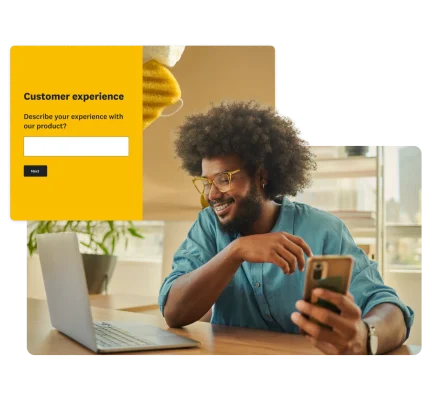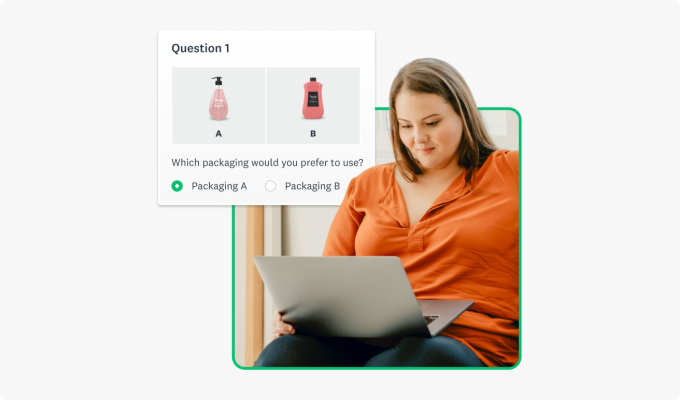The ultimate guide to product testing: What it is, types, and tips
Learn when and how to conduct product testing to create products that resonate with your customers and drive business revenue.

All too often, in a bid to recoup investment or to beat off the competition, brands rush new products to market to test whether they resonate with consumers. But, even the most experienced decision-makers struggle to make the right calls without input from their target audience.
Product testing gives your target audience various options and asks them to provide feedback. With product testing, you can compare purchase intent, quality, and value metrics to determine which product concepts customers like best.
In this article, we’ll examine why you should test your product concepts and how to conduct an effective product test.
What is product testing?
Product testing is the process of measuring the properties or likely performance of products among a target audience.
By seeking audience feedback on your product concepts before proceeding with a launch, you can quickly identify successful product ideas. This helps ensure that you allocate money and resources to the right projects.
Utilizing the best product testing companies is essential for gathering unbiased feedback. Most often, a third-party panel sample is used in product testing programs.
Why is product testing important?
If you’re developing a new product, one of the worst things you can do is wait until the end of the development stage to test whether your product lands with those you want to market it to.
The most successful products are tested regularly throughout the development process. Consumer testing is crucial in assessing product performance and market readiness, ensuring product quality, safety, and compliance with industry standards.
Incorporating customer feedback into the product development process:
- Builds brand equity: If you want people to come back or to shout about the product to prospective new customers, you’ll need to validate the suitability of your product for the end user.
- Reduces failure rate: Product testing can help to avoid costly errors or oversights by having the end user try out the product and send that all-important feedback.
- Assures quality: Too often, new products are recalled or must be developed because problems are only recognized once they’re sold.
- Promotes customer-centricity: Product testing allows developers to create according to customers’ verified needs, not guesses, preventing setbacks.
- Creates competitive edge: If you test your product with different segments of consumers, you’ll not only learn more about how the product works but how different end categories of customers use it. With this information, you can make more informed decisions about features, usability, and functionality that set your product apart from the competition.
- Ensures cost-efficiency: By testing your product before it reaches the market, you can ensure that every penny of your research and development adds value.
- Builds brand equity: If you want people to come back or to shout about the product to prospective new customers, you’ll need to validate the suitability of your product for the end user.

Types of product testing
Product testing is an overarching concept. There are several aspects of a product that you can test and ways to determine if your new product is on the right path.
Concept testing
Concept testing helps product teams evaluate an idea. Testing occurs before product managers and developers choose product names or write the first line of code.
Concept testing aims to measure audience interest and guide product development. Effective product marketing ensures the product meets customer needs and expectations throughout this process.
Alpha testing
Alpha testing is employees' first complete product test in the development stage. Product managers may have colleagues use a product in development to ensure it functions and meets business requirements.
Alpha testing aims to identify issues before the product is released to the public. Maintaining product quality during alpha testing is crucial to meet high standards.
Beta testing
Best testing is similar to alpha testing; however, real users conduct the testing in the production stage instead of employees testing the product. Beta testers provide an outside perspective that may not be evident to insiders and product managers.
Usability testing
A usability test is a method product managers use to observe how users use a product. Product managers ask testers to perform tasks and observe their actions to complete them.
The goal is to see if testers use the product as expected to achieve a goal. Evaluating a product's performance through usability testing is crucial to ensure it meets user needs and industry standards.
A/B testing
A/B testing, or split testing, compares multiple versions of a product and its features. Product managers use this type of testing to measure how testers rate versions of a product. Different methodologies for conducting product tests include Central Location tests and In-Home Use tests.
Performance testing
Performance testing is a type of testing used to determine a product’s stability, speed, scalability, and responsiveness. Product managers typically deploy performance testing on software products.
Performance testing aims to verify the product operates as expected and identify bugs. Adhering to quality standards during performance testing is crucial to ensure product reliability.
Safety testing
Product managers conduct safety tests to ensure products comply with consumer safety standards. Safety testing enhances user confidence and satisfaction with the final product.
Additionally, testing products is a core activity that helps ensure safety and compliance with industry standards.
Compliance testing
Compliance testing verifies whether a product adheres to specific regulatory standards and compliance requirements set forth by governing bodies. Companies can ensure their products meet legal obligations, thereby reducing the risk of liability and enhancing consumer trust.
Consumer testing
Sensory testing systematically evaluates how products engage and impact human senses, specifically sight, taste, smell, touch, and hearing. Evaluations are essential for product development, quality control, and marketing, ensuring products meet consumer expectations and enhancing sensory experience.
Participants in sensory testing can receive rewards, such as a free product, which helps attract panel members to the testing process.
Comparative testing
Comparative testing helps product managers understand how their product’s strengths and weaknesses measure against competitors. The purpose is to ideate areas of improvement to differentiate from competitors. Product testing sites play a crucial role in gathering diverse consumer opinions for comparative testing.
When to test a product
Product testing belongs to the development and growth stages of the product life cycle when testing new product ideas and adding new inventory. However, it is also relevant at all stages of the product lifecycle, including introduction, growth, maturity, and decline.
During the development stage, you’ll look for broad feedback that’ll help you make major decisions about your products. Ask respondents to choose between several very different product concepts, for example.
Because everything about your brand is new, it’s the best time to field broad, directional feedback on your products.
You may seek more nuanced feedback on your product concepts during the growth stage. This is the time to ask respondents focused questions about new product features or niche alternatives to current products.
It’s also the time to think about sampling your loyal customers to see if they’re on board with your new ideas.

How to conduct a product test effectively
Define your objectives
Before considering your audience or testing method, you must clarify your product testing research objectives. What’s your desired outcome? Do you want to understand customer preferences? Test product usability? Adjust pricing structure? Your objective will guide your research plan and data analysis plan, so you can understand how to test if a product will sell.
Select the right audience
Your target audience can help you decide which product concepts are worth pursuing and which you should set aside. There are two ways to get feedback from this group of people:
- A focus group lets you collect in-depth feedback on various questions. However, they can be costly to organize, and you might not be able to gather feedback from a representative sample of your target audience.
- SurveyMonkey Audience is a market research panel that lets you target who you want to reach and then collect feedback from them in minutes. Audience is more cost-effective than a focus group, but a little less in-depth.
Choose the right testing method
The efficacy of your product testing market research results is dependent on your testing method. Go back to your objective. What type of product testing best aligns with your goal?
| Concept testing | Test early-stage ideas |
| Alpha testing | Colleagues and internal experts examine a product |
| Beta testing | External testers examine the product |
| Usability testing | Analyze the functionality of your product |
| A/B testing | Compare product features |
| Performance testing | Ensure the product, often software, performs as expected |
| Safety testing | Guarantee the product meets safety standards |
| Compliance testing | Ensure your product complies with government and industry regulations |
| Sensory testing | Evaluate how the product impacts user’s senses |
| Comparative testing | Understand how your product’s features, price, and more compare to competitors |
Conduct the test and gather feedback
Utilizing a product testing survey template can greatly improve the effectiveness of gathering feedback on a newly developed product. These surveys should include well-crafted questions designed to elicit comprehensive insights from participants.
Product testing example questions may include:
- Usability assessment: How intuitive did you find the product's features during your first use?
- Performance testing: Can you describe your overall experience with the product?
- Comparative testing: How does this product compare to others you have used in the same category?
- Overall satisfaction: On a scale of 1 to 10, how likely are you to recommend this product to a friend or colleague?
By employing such targeted questions, a structured product testing survey can yield valuable feedback that aids in refining the product and enhancing user satisfaction.
Analyze results and make data-driven decisions
If survey design is a skill, data analysis is a competency that you must spend an equal amount of time nurturing.
Start with a data analysis plan. A data analysis plan outlines the steps, strategies, and methods you plan to use to analyze your gathered data.
A typical plan includes cleaning, inspecting, and analyzing data; however, you should refer back to your original product testing market research objective and plan. For example, your objective will inform your research method.
Data analysis takes resources like time, money, and expertise. However, with the right tools, you don’t need to be a data scientist or survey expert. The SurveyMonkey Market Research Solution offers AI-powered insights to expedite data analysis. The platform is designed to help you get quick insights that drive better decisions.
Product testing vs. concept testing: Which is better?
Is product testing or concept testing better? Well, it depends on your product development stage and your goals.
Concept testing is a market research method that allows you to refine a product idea by getting feedback from your target market. This type of testing occurs early in the product lifecycle before the product is developed.
Product testing is a research method that occurs during the development stage. Product managers test product design, functionality, usability, and compliance.
Neither product testing nor concept testing is “better.” The best option is dependent on your goals and timeline. To validate a product idea, concept testing may align with your needs.
However, if you want to ensure that your product functions as designed, a product test (more specifically, a performance test) will serve you better.

Tips for accurate product testing
Product testing is a vast discipline—and for good reason. Time, money, and intellectual capital are poured into product development. A product's success is a validation of those allocations; however, a failure could mean trouble on the horizon.
Every little bit counts, including these tips to remember for accurate product testing.
Use real-world testing scenarios
Ensure you maintain consistent metrics across all stimuli during your product testing process.
It is essential to pose the same questions for each product concept, enabling you to conduct an accurate and meaningful comparison among the various options.
By standardizing your approach, you can identify strengths, weaknesses, and unique attributes more effectively, leading to informed decision-making. This uniformity in questioning will help minimize bias and ensure that each concept is assessed on a level playing field.
Iterate based on test results
Iterate based on the findings from usability test results.
For instance, the product team may modify the font style, size, or weight in response to feedback indicating that users found the previous font difficult to read or unappealing.
Maintaining a cycle of continuous usability testing is crucial, revisiting the same parameters each time, such as user demographics, task completion rates, and satisfaction scores, to ensure that any updates lead to tangible improvements in user experience.
By systematically analyzing and incorporating insights from each round of testing, the team can refine the product incrementally, enhancing its usability and overall appeal to users.
Measure success metrics
What makes a good product? The metrics you choose to measure will help you decide.
The questions you ask in your product testing survey can be as specific as you’d like. For example, if you want to know whether your audience finds a certain feature useful, you might ask about its innovativeness, relevance, and value.
In general, these are some key metrics you might want to include in your survey:
- Appeal: Is your product enticing to potential customers?
- Believability: Is your product’s messaging believable?
- Innovativeness: Is your product innovative?
- Purchase intent: Do people want to buy your product?
- Quality: Does your product seem high quality?
- Relevance: Does your product fulfill your audience’s needs and wants?
- Uniqueness: Is your product different from other products?
- Value: Is your product a good value?
Document test procedures and results
Product testing is not a one-and-done process. You should continue testing throughout product development, from concept to performance testing.
Document test procedures to control for specific variables. For example, you should document any change to survey demographics. The opposing demographic groups may give conflicting opinions that can impact later ad copy, marketing campaigns, and more. It could also lead to a new market segment or product concept.
Benchmark your results with existing products
If you’re building on an existing product, include that product in your survey. The results will help you decide whether or not your new concept can compete with your original product or your competition's products.
Improve your product testing efforts with SurveyMonkey
Since you understand why testing your products is important, know how to run your test, and have some useful testing tricks up your sleeve. Now, it’s time to jump into your product testing survey. If you want results fast, we can get you some in less than an hour.
Discover more resources

Understand your target market to fuel explosive brand growth
Brand marketing managers can use this toolkit to understand your target audience, grow your brand, and prove ROI.

See SurveyMonkey in action: Event registration and feedback

Hornblower enhances global customer experiences
Discover how Hornblower uses SurveyMonkey and powerful AI to make the most of NPS data, collect customer insights, and improve customer experiences.

Marketing trends: 3 strategies to stay relevant and ready for what's next
New SurveyMonkey research reveals critical insights on the state of marketing. Discover marketing trends to fuel your strategies and stay relevant.